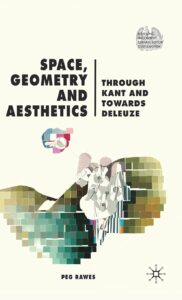“Peg Rawes’ Space, Geometry and Aesthetics: Through Kant and Towards Deleuze delves into a unique exploration of aesthetic geometries within ontological philosophy. The work is rooted in a post-Kantian framework of aesthetic subjectivity, charting a path through geometric thinking and figurations such as reflective subjects, folds, passages, plenums, envelopes, and horizons. These concepts are explored across ancient Greek, post-Cartesian, and 20th-century Continental philosophies, offering insights into the construction of space and embodied subjectivities.
The book is structured around six chapters, each dedicated to examining ‘geometric’ texts from influential thinkers like Kant, Plato, Proclus, Spinoza, Leibniz, Bergson, Husserl, and Deleuze. Rawes highlights geometry as a profoundly embodied aesthetic activity, where each geometric method and figure is charged with aesthetic sensibility and sense, as opposed to being mere disembodied scientific methods.
An ontology of aesthetic geometric figurations is traced from Kant’s critical writings, reaching back to Plato and Proclus’ Greek philosophy, through Spinoza and Leibniz’s post-Cartesian philosophies, and moving forward to Bergson’s concept of ‘duration’ and Husserl’s ‘horizons’, culminating in Deleuze’s philosophy of sense. This intricate exploration provides a productive framework for understanding space and embodied subjectivities within a broad philosophical context.
Contents
Acknowledgements ix
Series Editor’s Preface x
Preface xiii
Introduction 1
Space 2
Geometry 3
Aesthetic geometric figure-subjects 4
1 Drawing Figures 9
Part I: Embodied Figures 9
Forms of pure intuition 11
Synthetic and analytic relations 13
Space and time 15
External and internal differentiations of space 17
Part II: Drawing Figures 19
Acts of construction 19
Reflective judgment 20
The imagination 22
Drawing a line 29
Summary 31
2 Folding-Unfolding 34
Discursive geometry 37
Soul 41
Imagination 44
Limit and unlimit 48
Imagination, limit and unlimit 51
Discursivity of the elements 54
Figure 57
Summary 60
3 Passages 62 Geometric methods after Descartes 62 Geometric method in the Ethics 65 Substance 68 Passage I: attributes, modes, affects and common notions 72 Passage II: reading the text 82 Passage III: modes of geometric thinking 84 Summary 89 4 Plenums 91 The transition from synthetic to analytic geometry 94 Corporeal magnitude 99 Incorporeal magnitude 103 Sufficient reason 109 The plenum 113 Summary 119 5 Envelopes 121 Limit and unlimit 123 Extensity 126 Body-image and perception 128 Memory 132 The envelope 135 Space and time 136 Intuition 141 Envelope I: intuition as duration 143 Envelope II: intuitive philosophy 145 Envelope III: natural geometry and intuitive construction 146 Summary 151 6 Horizons 154 Geometric reason and ‘Teleological-historical reflection’ 156 Geometric sense-ideas and sense-intuitions 161 Explication 165 Retrieving sense-intuition from Descartes and Kant 169 Geometric self-evidence 173 Horizons 175 Horizon I: intersubjectivity 178 Horizon II: we-horizons and future-horizons 180 Summary 182 Notes 184 Bibliography 202 Index 207
Related books: The Poetics of Space by Bachelard and Conscious Acts of Creation: The Emergence of a New Physics” by William A. Tiller
Summary of “Deleuze and Space,” edited by Ian Buchanan and Gregg Lambert

